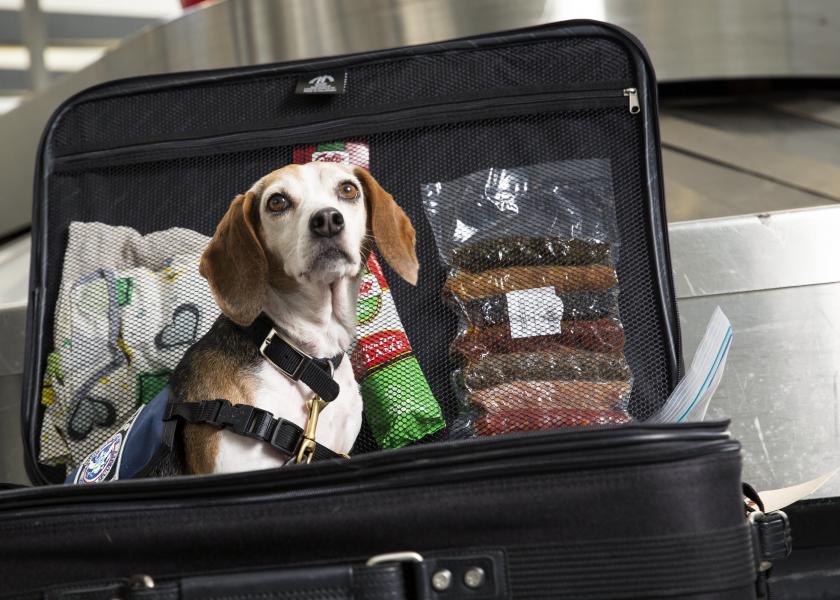6 Ways USDA APHIS is at Work to Protect Your Pigs

Keeping U.S. animals healthy is a top priority for the USDA's Animal and Plant Health Inspection Service (APHIS). One of the agency's many efforts is to prevent deadly foreign animal diseases like African swine fever (ASF) from reaching the U.S. while also preparing for a possible introduction of the disease.
“The United States has always had a system of interlocking safeguards in place to protect against foreign animal diseases, however the spread of ASF abroad made us review and strengthen our protections," says Rosemary Sifford, U.S. Chief Veterinary Officer.
Here are six ways APHIS is at work to protect the U.S. swine herd.
1. Enhancing Existing Safeguards
Since ASF was detected in the Dominican Republic and Haiti in 2021, APHIS has enhanced several existing safeguards.
• Strengthened partnership with Customs and Border Protection staff at ports of entry
• Increased inspection of passengers and products arriving from affected countries
• Advanced risk-based restrictions on imports of pork and pork products from affected countries
• Continued collaboration with states, industry and producers to relay the importance of strict biosecurity procedures
• Evaluated and improved response plans and have incident management teams ready to deploy should a detection occur in the U.S.
2. Establishing a Protection Zone in Puerto Rico, U.S. Virgin Islands
In September 2021, APHIS established a protection zone for Puerto Rico and U.S. Virgin Islands, after ASF was discovered in the Dominican Republic and Haiti. This protection zone allows APHIS to work closely with both territories to increase education and outreach and improve biosecurity, while also safeguarding the entire U.S. swine herd and protecting the interests and livelihoods of all U.S. pork producers. APHIS’ Plant Protection and Quarantine predeparture screenings and United States Postal Service mail inspections are critical to this effort, APHIS points out.
3. Strengthening Swine Disease Surveillance and Testing
APHIS increased ASF surveillance efforts, looking more closely for the disease. ASF surveillance in Puerto Rico has included:
• Collecting more than 4,800 samples during slaughter surveillance
• Surveying all known Puerto Rico swine premises, with over 9,600 samples tested
• Inspecting 300 illegal boat landings
• Removing more than 4,600 feral swine and testing more than 2,900 for both ASF and classical swine fever (CSF)
APHIS continues to conduct surveillance for both ASF and CSF in domestic and feral swine in the mainland U.S. Since August 2021, APHIS has tested almost 6,000 samples from higher risk domestic herds, and more than 26,000 case-compatible samples from veterinary diagnostic laboratories and production facilities. Since May 2022, APHIS has surveyed feral swine in very high-risk counties within nine states where operational feral swine removal activities are underway and tested more than 3,600 samples, with no ASF detections. APHIS has also started to expand feral swine surveillance and removal activities along the U.S. Mexico border and the Florida Gulf Coast.
4. Updating the African Swine Fever Response Plans
APHIS made significant updates to ASF response plans for domestic pig and feral swine response. These updates are the result of intensive collaborations with the APHIS ASF Technical Working Group, the ASF Harvest Establishment Working Group, and the United States Animal Health Association Swine Committee. The updated materials include a revised ASF Redbook, Harvest Facility Response Plans, Control Area Permit Templates, and responder “Playbooks” for domestic pigs and feral swine. Updated plans are posted on the APHIS ASF response page, the agency notes.
5. Opening the National and Bio Agro-Defense Facility
APHIS has been working closely with USDA’s Agricultural Research Service and the U.S. Department of Homeland Security to stand up the National Bio and Agro-Defense Facility (NBAF) in Manhattan, Kan. This state-of-the-art facility is the first U.S. maximum biocontainment, biosafety level 4 laboratory for large livestock and a national asset that will help protect the nation’s agriculture, farmers and citizens against the threat and potential impact of serious animal diseases. NBAF will provide 24/7 diagnostic testing to detect and respond to foreign animal diseases. It will also develop vaccines and diagnostics for high-consequence animal diseases and will be able to train more veterinarians and diagnosticians to detect key animal diseases—which is critical to global food security, APHIS explains.
6. Enhancing Awareness of African Swine Fever Through the ‘Protect Our Pigs’ Campaign
APHIS continued efforts to help prevent ASF through an outreach and awareness campaign called “Protect Our Pigs.”
"The U.S. is one of the world's largest pork producers and the second largest exporter of pork globally," APHIS writes. "If this deadly, highly contagious, viral disease arrives here, it is estimated it could cost the nation $74 billion dollars over 10 years. Commercial pork producers, veterinarians and pig owners are among the nation’s first line of defense against ASF."
The Protect Our Pigs campaign deploys a variety of outreach efforts to support these critical stakeholders, including downloadable fact sheets and posters, instructional videos, shareable social media graphics and a new interactive biosecurity guide. To date, these efforts have appeared in social media feeds over 38 million times and have led to nearly 150,000 visits to the Protect our Pigs web page, APHIS notes.
More from Farm Journal's PORK:
US SHIP Delegates Elect First General Conference Committee
USDA's Third Annual African Swine Fever Action Week Set to Begin Oct. 2
Foreign Animal Disease: The Threat Isn’t Going Away for Pork Producers







